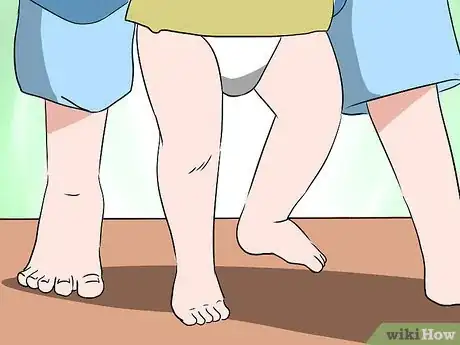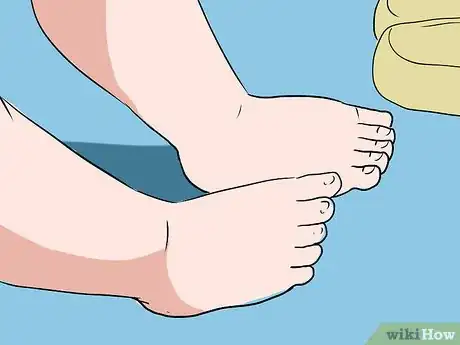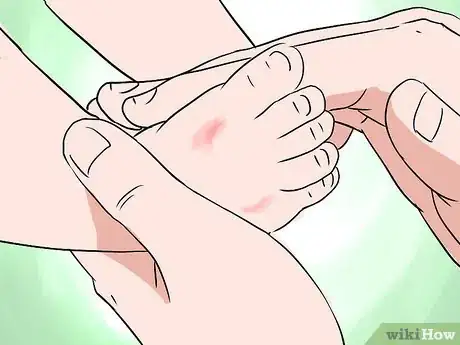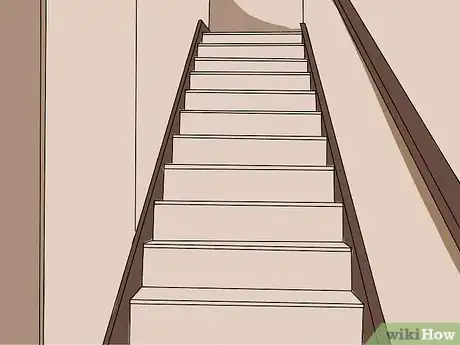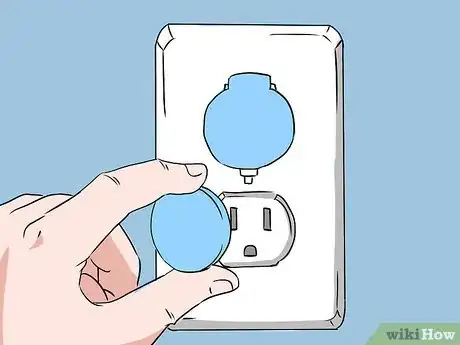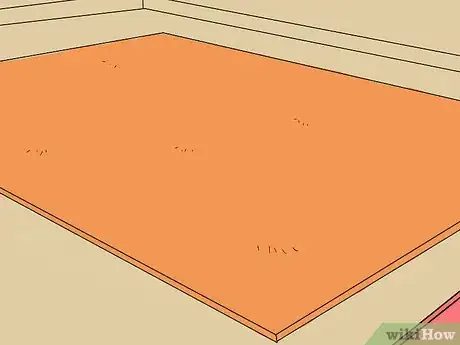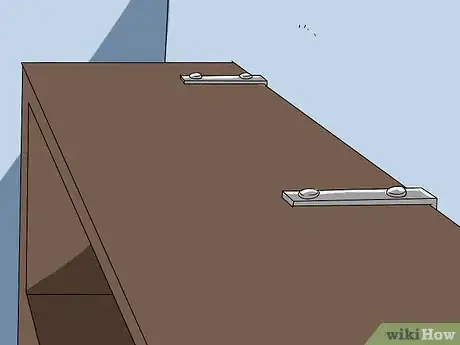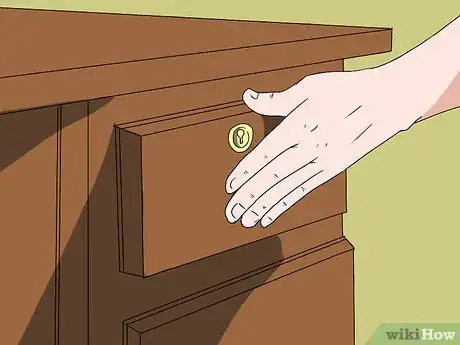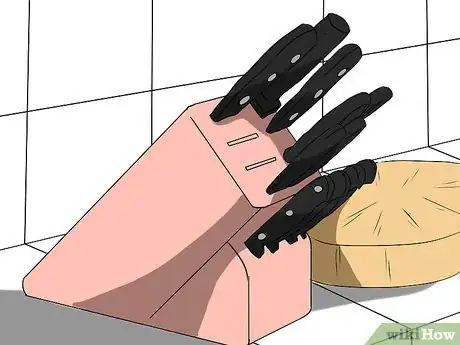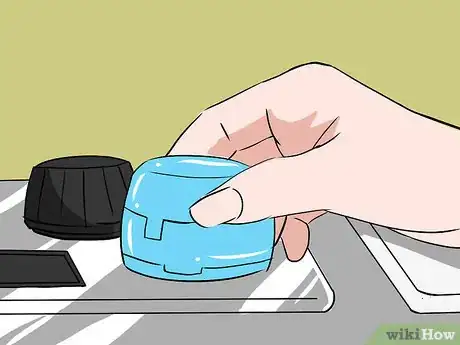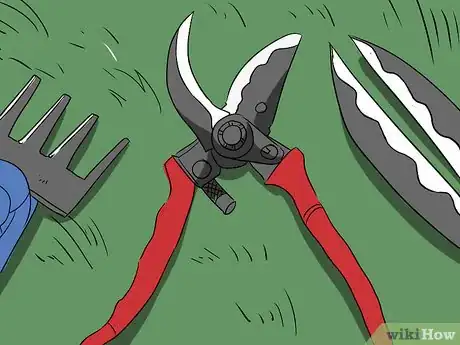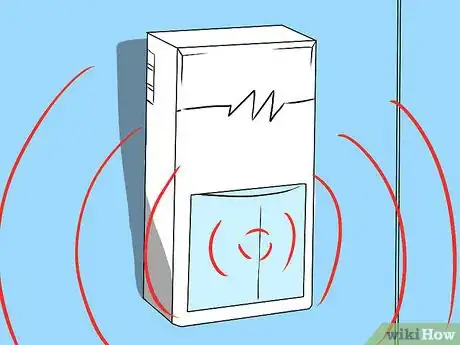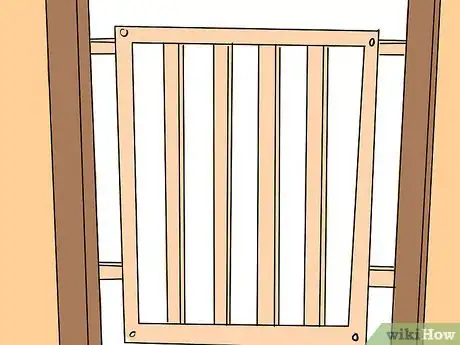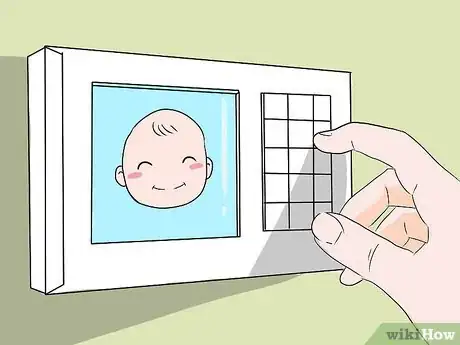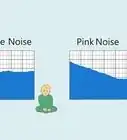X
wikiHow is a “wiki,” similar to Wikipedia, which means that many of our articles are co-written by multiple authors. To create this article, volunteer authors worked to edit and improve it over time.
This article has been viewed 13,544 times.
Learn more...
Walking is a huge milestone in a child's life. The newfound mobility and independence are exciting and terrifying for parents and children alike. As your baby wobbles and falls, it becomes even more difficult to keep them safe. Avoid injury by creating a safe environment for your child to learn to walk in.
Steps
Method 1
Method 1 of 4:
Keeping an Eye on Your Child
-
1Help your child to learn how to balance. A new walker is still figuring out how their body works, so always keep an eye on your child as they take their first steps. Help your child learn balance by supporting them and holding their hands as they begin to walk. They will soon be able to stand and walk on their own, but by holding their hands, you will help them avoid many of the spills that come with the first walking attempts.
-
2Take your baby's shoes off when they are trying to walk. Being barefoot will help your child to stay upright because bare feet can help improve your child's balance and lessen the number of falls they take.
- When your child goes outside or to public places, put them in a pair of flexible shoes that are made for children who are starting to learn how to walk.
Advertisement -
3Assess your child any time they take a spill. If your child falls (and it's inevitable that they will), measure the severity of the fall and any injuries they sustained while offering them comfort and support.
- After more serious injuries, keep an eye on your child to track their recovery. If they seem slow, groggy, or to be favoring a certain leg or side of their body, take them to the doctor.
-
4Follow the baby-proofing basics. An increase in mobility means that very little is off-limits to your child. Keep them safe by baby-proofing your house. You are probably aware of the danger areas in your home from your child's exploits in crawling and cruising. Typical danger areas include:
- Stairs, where it is important to install a baby gate at the top and bottom.
- Heated surfaces, such as radiators or furnaces, need to be covered with a grill or blocked by other furniture so a walking baby can't reach them.
- Cover electrical outlets with simple childproof plastic covers to avoid a child putting his or her fingers in the plug. To make sure everything is covered, get on your hands and knees to see things from a toddler's point of view—this should help you to see potential hazards.
Advertisement
Method 2
Method 2 of 4:
Making Your House Safe for Your Child
-
1Remove clutter from the floor. Pick things up off the floor, including rugs or anything that could trip a toddler. Changes in flooring are particularly treacherous for a new walker, so be on the lookout for rough floor transitions or uneven flooring.
- Dangerous floor can be easily covered with a foam play mat. Most play mats come in a variety of sizes and are made of connecting squares so that you can customize the mat to fit your space. Simply place the mat over the floor for a safer walking surface for your baby—no tools or installation required.
-
2Secure large pieces of furniture that can tip over easily. Secure large pieces of furniture, like bookshelves and entertainment systems, to the wall. These large pieces of furniture can tip over easily if your baby walks into them or tries to climb them.
- Attach the furniture with special baby proofing furniture hooks, found at your local home supply store, or simply use a few extra screws and hooks to make sure everything is safely attached to the wall.
-
3Be on the lookout for sharp corners of furniture. Add padding to sharp corners, which are often at head level, and remove and replace dangerous pieces. Furniture made out of hard materials, such as glass and stone, can be especially harmful. Pre-made furniture bumpers can be purchased; simply slide these bumpers onto the dangerous surfaces.
- You can also make your own bumpers with quilt batting or pool noodles cut in half and slid over the rough edge.
-
4Keep your baby safe while they are in their crib. Now that your baby can stand up and walk, not even their own room is safe. Readjust the crib to the lowest position by removing the mattress and adjusting the bottom springs so they can't climb out in the night.
- Move the crib away from dangerous areas, such as windows and doors, or places where a child could climb or fall.
-
5Baby-proof your windows. Most children probably couldn't reach windows before they could walk, but now windows pose a great safety threat. Install window guards, or adjustable mesh screens to stop your child from being able to open the window and fall out.
- Window guards come with adjustable hardware that can be attached directly to the inside of the window or window frame. The result is a screen that doesn't block the view, but blocks the option of a baby opening or climbing out the window.
-
6Tie back loose curtains or blind strings to avoid the risk of strangling. A simple way to do this is to loop blind cords together in a loose knot or tie the cords around a blind winder to keep them untangled and out of your baby's reach.
-
7Keep your child safe from your fireplace. Fireplaces are especially dangerous because there are lots of way for children to get hurt, but they are also very appealing to a mobile toddler. Protect your baby from the fireplace by installing a fireplace lock. Similar to an oven lock, most fireplace locks connect with an adhesive strip to the wall and make it difficult for your child to open the fireplace door.
- If you have a larger hearth and fireplace area, install a fireplace gate that wraps around and blocks off the entire area. These gates are typically installed with screws or hooks attached to the wall on either side of the fireplace and wrap around the front.
- Place furniture bumpers on hard edges of a fireplace to create a soft landing.
Advertisement
Method 3
Method 3 of 4:
Using Caution in the Kitchen and Bathroom
-
1Keep your cabinets closed and secure. Lock away harmful liquids and chemicals, such as medicine and cleaning supplies, and make sure your cabinets are secured with childproof locks. Simple push down brackets can be screwed into cabinets and connected to the door to make cabinets nearly impossible for a baby to open but not be too inconvenient for adults.
- Other popular locks use magnets to connect cabinet doors and can be disabled when the baby is not around. Visit your local super center or baby supply store for a selection of baby locks.
-
2Put dangerous supplies in cabinets that are high off the ground. Take extra precautions in the kitchen by moving dangerous kitchen utensils, such as knives and heavy dishes, to higher cabinets where they can't be reached by a mobile toddler.
-
3Keep your child safe from the stove. Protect against a hot stove and oven by installing stove knob covers that stop children from accidentally turning on the stove. Most models simply pop on to cover the knobs and can be removed for adult use by opening the hinged front.
- Oven locks are also simple to install via an adhesive strip that connects the top of the oven to the oven door, making it nearly impossible for a curious child to open the oven door.
Advertisement
Method 4
Method 4 of 4:
Practicing Outdoor Safety
-
1Remove any unsafe items from your yard. Do a sweep of outside areas to locate and remove any unsafe items that might be dangerous for a mobile baby.
- Items like lawn equipment, toys for older children, and gardening tools should be kept in a locked shed out of the reach of your baby.
-
2Install a motion detector in your garage. Call your garage door manufacturer to install a motion detector on the garage door to ensure that it will stop closing if it detects the motion of your child nearby.
-
3Take precautions if you have a pool. If you have a pool, install special exterior baby gates around it and make sure to always monitor your baby when he or she is outside. A fence that is at least four feet tall with gaps no wider than three inches should be installed around the perimeter of the pool. For extra protection, cover the pool with a rigid, motorized cover, as flimsy plastic covers can cave in if a child walks on top.
- Pool professionals in your area can recommend specific products and install all of your pool safety needs.
-
4Set up an alarm system. If your home has an alarm system, set it to chime or beep whenever a door or window is opened. This will help you to intercept an escaping child and prevent disaster before it occurs.
Advertisement
About This Article
Advertisement
